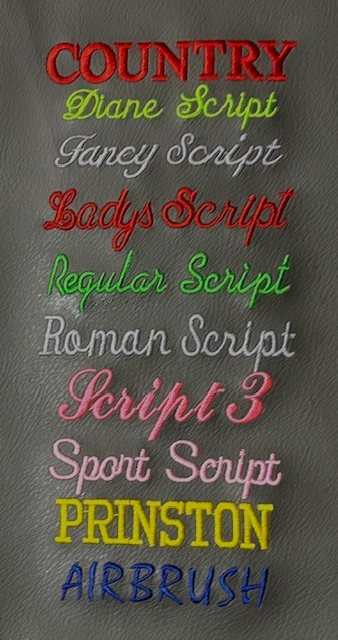Personalized School Uniforms with High-Quality Embroidery Providers
Personalized School Uniforms with High-Quality Embroidery Providers
Blog Article
The Art of Personalized Needlework: Unlocking the Keys to Creating Unique and Unforgettable Layouts
The tricks to developing custom embroidery styles that astound the eye and leave a long-term impression lie in a fragile balance of method, creativity, and focus to information. As we dive into the world of custom needlework, we uncover the nuanced interaction in between string selection, stitch intricacy, and style personalization that elevates a plain garment to a work of art.
Picking the Right Needlework Threads
When choosing embroidery strings, what key elements should you think about to make sure the very best results for your personalized styles? The selection of needlework string is crucial in establishing the last result of your embroidered design. One of the main factors to consider is the material of the string. Different materials such as cotton, polyester, rayon, and silk use differing levels of shine, toughness, and structure. It is vital to select a string product that complements the textile you are stitching on and straightens with the wanted look of the style.
Furthermore, the weight or thickness of the thread plays a substantial duty in the appearance of the embroidery. Thicker threads can add measurement and texture to your layout, while finer strings are suitable for detailed information and small text. Additionally, taking into consideration the shade fastness and washability of the thread is vital to guarantee that your personalized layouts keep their quality and vibrancy with time. By carefully assessing these variables and choosing top notch strings that fulfill your specific demands, you can improve the visual appeal and durability of your stitched developments.
Checking Out Different Stitch Methods
To dive right into the realm of 'Discovering Various Stitch Methods', one need to understand the details and nuances that each stitching technique offers the art of embroidery. Various stitch techniques not only add visual passion but additionally add to the general texture and dimension of the design. One popular stitch technique is the satin stitch, which includes very closely jam-packed parallel stitches to create a smooth and glossy surface, ideal for filling up in shapes and producing strong lays out.
On the various other hand, the backstitch is a flexible technique frequently made use of for describing and including great details. It includes sewing in reverse to produce a strong line of needlework. Furthermore, the French knot stitch adds a tactile element to designs, ideal for developing textured accents like blossom facilities or decorative touches.
Discovering different stitch methods permits embroiderers to have fun with light, shadow, boss stretch tailoring and depth within their layouts, boosting the visual appeal and imaginative high quality of their needlework tasks. By understanding various stitching methods, one can open countless opportunities for creating one-of-a-kind and memorable customized embroidery items.
Incorporating Personalized Design Aspects
Having actually checked out the complexities of different stitch techniques such as the satin stitch, backstitch, and French knot, the emphasis now shifts in the direction of incorporating customized design elements in customized needlework projects. Individualized layout elements play an essential function in making needlework jobs absolutely one-of-a-kind and unforgettable.
One more way to integrate individualized design elements is by consisting of signs or motifs that hold unique significance to the recipient or show their rate of interests and individuality. As an example, including a favorite flower, pet, or hobby-related symbol can make the needlework style more significant and personalized. In addition, choosing colors that reverberate with the recipient or straighten with the designated motif can additionally enhance the customization of the embroidery project.
Understanding the Art of Color Sychronisation

One key facet of color coordination is comprehending color concept. This consists of recognizing exactly how different shades interact with each various other, the feelings they convey, and exactly how they can be integrated to develop visually appealing layouts. By applying color concept principles, embroiderers can develop harmonious color combinations that enhance the overall look of the design.
Furthermore, taking note of comparison is crucial in shade sychronisation. Using contrasting colors can help specific components of the layout pop, improve clarity, and develop a visually vibrant embroidery item. By grasping the art of color control, embroiderers can boost their styles and develop unforgettable pieces that reverberate with customers and customers alike.
Enhancing Appearance With Advanced Needlework Stitches
French knots, for example, are best for including little, raised dots to your design, mimicking the appearance of grains or developing a textured surface area. Bullion knots, on the various other hand, can be used to produce twisted, ropelike aspects that add a luxurious feel to the needlework. Seed sewing entails little, scattered stitches that can load in locations with a speckled appearance, while turkey work develops fluffy, dimensional accents evocative animal hair or vegetation. Try out these advanced needlework stitches allows you to push the boundaries of traditional needlework and create really one-of-a-kind and aesthetically enticing structures in your styles.
Conclusion
To conclude, the art of personalized needlework includes a combination of choosing the appropriate threads, exploring numerous stitch strategies, including tailored style components, grasping color sychronisation, and boosting texture with sophisticated stitches. By recognizing and executing these vital elements, embroiderers can create one-of-a-kind and unforgettable styles that display their imagination and skill. Needlework lovers can open the keys to developing stunning and bespoke pieces that stick out and leave an enduring impact.
Report this page